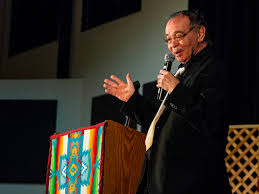The Life and Legacy of Hank Adams: A Pioneer in Indigenous Rights

Introduction to Hank Adams
Hank Adams, a prominent figure in the movement for Indigenous rights, grew up against the rich backdrop of Native American culture. Born in the mid-20th century, his formative years were marked by both the challenges faced by Indigenous communities and the vibrant traditions that defined his heritage. Adams belongs to the Assiniboine and Sioux tribes, which greatly influenced his identity and commitment to advocating for Native issues. The historical context of his upbringing during a time of significant civil rights movements in the United States played a crucial role in shaping his worldview.
In his early years, Hank Adams witnessed firsthand the effects of systemic injustices faced by Indigenous peoples. These experiences instilled in him a passionate drive to champion the rights of Native Americans. He became actively involved in various social justice causes, which ultimately led him to the forefront of Indigenous activism. A pivotal event that cemented his dedication was the activism surrounding the 1970s campaigns for tribal sovereignty and treaty rights. Adams was instrumental in these efforts, using his voice and platform to draw national attention to the plights of Indigenous communities.
Moreover, Adams’ education played a vital role in his advocacy journey. He pursued higher education, which equipped him with the skills needed to articulate the issues facing Indigenous peoples effectively. Through his experiences, he learned about the complexities of legal frameworks impacting tribal lands and rights, allowing him to strategize more effectively when addressing these challenges. Hank Adams thus emerged as a key figure who not only represented Indigenous interests but also educated broader audiences on the need for social justice and equity within the context of Native American rights.
Hank Adams’ Early Activism
Hank Adams emerged as a prominent advocate for Indigenous rights during the turbulent 1960s and 1970s, a period marked by widespread civil rights activism across the United States. He was inspired by the social movements that sought justice and equality, which sparked his commitment to address the systemic injustices faced by Native American communities. Adams’ early activism was characterized by his participation in significant initiatives that sought to bring attention to Indigenous issues and promote self-determination.
One of the pivotal moments in Hank Adams’ early activism occurred when he took part in the American Indian Movement (AIM), a grassroots organization that sought to address the grievances and injustices faced by Native Americans. The organization was instrumental in raising awareness about issues such as treaty rights, police brutality, and the preservation of Indigenous culture. Adams, through his various roles, quickly became a vital figure in efforts that broadened the conversation on Indigenous rights.
Additionally, in 1970, Hank Adams played a crucial role in the Trail of Broken Treaties, a cross-country caravan that culminated in a march on Washington, D.C. This event aimed to draw attention to the U.S. government’s failure to honor treaties with Native American tribes. The caravan brought together activists from across the nation and highlighted the urgent need for policy change regarding Indigenous rights and sovereignty.
Furthermore, Adams worked tirelessly to sever the ties between poverty and discrimination in Indigenous communities. He was actively involved in legal battles and campaigns that sought to secure land rights and educational opportunities for Native Americans. Through these initiatives, Hank Adams not only influenced Indigenous communities but also contributed to the broader civil rights movement by emphasizing the need for equality and recognition of Indigenous sovereignty.
Key Contributions to Indigenous Rights
Hank Adams has played a pivotal role in promoting Indigenous rights throughout his career, significantly impacting policy, legal frameworks, and community organization within Native American contexts. One of his most notable contributions is his involvement in landmark litigation cases that have reshaped the relationship between the federal government and Indigenous communities. Adams’s advocacy was instrumental in the 1970s and 1980s cases that aimed to protect tribal sovereignty and uphold treaty rights, setting important legal precedents for future generations.
In addition to legal battles, Hank Adams has been a critical voice in policy development, working to ensure that Indigenous perspectives are included in legislative discussions. His efforts have helped to raise awareness about the challenges faced by Native American populations, leading to significant reforms in policy that address issues such as land rights and cultural preservation. His participation in the American Indian Movement (AIM) during its formative years further amplified Indigenous concerns at both local and national levels, fostering greater understanding among non-Native communities.
Another of Adams’s key contributions is his role in establishing organizations dedicated to advocating for Native American rights. He was a co-founder of the National Indian Youth Council, which played a vital role in mobilizing young Indigenous individuals to speak out against injustices and engage in activism. This council has significantly influenced Indigenous youth empowerment and leadership over the decades. Furthermore, Hank Adams has tirelessly worked to build coalitions among various Indigenous groups, thereby strengthening their collective voice in confronting legislative and social challenges.
Through litigation, policy reform, and organizational leadership, Hank Adams has left an indelible mark on Indigenous rights, inspiring new generations to continue the fight for justice and recognition. His legacy serves as a foundation upon which ongoing Indigenous advocacy is built, ensuring that the rights and needs of Native American communities remain at the forefront of national discourse.
Hank Adams and the Fish Wars
During the 1970s, a significant conflict emerged in the Pacific Northwest, known as the Fish Wars, which highlighted the struggle of Native American tribes for their treaty-protected fishing rights. At the forefront of this movement was Hank Adams, a dedicated advocate for Indigenous rights and a prominent leader in the fight for sovereignty and self-determination. The Fish Wars were not merely regional disputes; they represented a broader challenge to the systemic neglect of Native American treaties, which had guaranteed fishing rights to tribes long before statehood.
Hank Adams played a pivotal role in mobilizing tribal communities and raising public awareness regarding the injustices they faced. The disputes arose when state governments imposed regulations that restricted Native Americans from fishing in their traditional waters, undermining treaties that had been established with the U.S. government. Adams recognized the necessity of legal action to uphold these treaties and protect cultural practices integral to tribal identity.
The conflict escalated as numerous tribes joined forces to assert their rights through organized protests and court actions. The court cases, particularly the landmark case United States v. Washington, highlighted the inadequacies of state laws against the backdrop of federal treaties. Hank Adams emerged as a key figure, not only in the courtroom but also in the media, where he effectively communicated the tribes’ plight to a wider audience. His leadership galvanized support and helped illuminate the struggles of Indigenous peoples in the fight for recognition and respect.
As the Fish Wars unfolded, Hank Adams’ advocacy led to a significant victory in 1974, when Judge George Hugo Boldt affirmed the tribes’ rights to fish, a decision that became crucial in reshaping the understanding of treaty rights across the country. Adams’ contributions during this tumultuous period solidified his legacy as a trailblazer for Indigenous rights, proving instrumental in the broader movement toward achieving justice and acknowledgment for Native American communities.
The Fight for Land and Sovereignty
The struggle for land and sovereignty is at the heart of Native American rights, and Hank Adams played a significant role in advocating for these critical issues. Throughout the 20th century, many Indigenous tribes faced challenges regarding the recognition and protection of their ancestral lands. The effects of colonization, broken treaties, and government policies continually undermined their sovereignty and led to a loss of cultural heritage. Adams emerged as a vocal advocate, addressing these injustices and striving to restore rights that had long been denied.
Hank Adams recognized the importance of land not only as a physical space but also as a vital component of identity for Indigenous peoples. He advocated for the recognition of tribal sovereignty, arguing that self-determination and control over land are essential for cultural preservation and community well-being. Adams actively participated in numerous grassroots initiatives, conferences, and legal battles that sought to address these pressing issues. His efforts included lobbying for the restoration of land to tribes and emphasizing the need for policies that respect and recognize Indigenous rights.
In his advocacy, Adams often highlighted the resilience and determination of Native communities in the face of systemic oppression. He believed that true justice could only be achieved through active resistance against injustices and engaged citizens who demanded accountability from various stakeholders, including the federal government. By amplifying the voices of those affected and guiding efforts to reclaim land and sovereignty, Hank Adams left an indelible mark on the Indigenous rights movement. His commitment to fighting for land rights continues to inspire current and future generations, reminding us of the vital need to honor and respect the ancestral lands of Native American tribes.
Hank Adams’ Philosophical Approach to Activism
Hank Adams’ activism is deeply rooted in a set of philosophical beliefs that emphasize the importance of grassroots organizing, cultural preservation, and intertribal cooperation. His approach was not only strategic but also reflected a profound understanding of social justice and community empowerment, resonating with the needs of Indigenous peoples across North America.
At the core of Adams’ philosophy was the belief that true change must arise from within the community itself. He understood that only through grassroots organizing could the voices of Indigenous communities be effectively amplified. This is exemplified by his tireless efforts in mobilizing individuals at the local level, fostering a sense of empowerment that encouraged them to take an active role in their advocacy. For Adams, activism was not merely about addressing immediate grievances but about nurturing a culture of participation and leadership within Indigenous groups.
In addition to grassroots efforts, the preservation of cultural identity was paramount in Hank Adams’ work. He recognized that the heritage and traditions of Indigenous peoples are not only vital to their identity but also serve as powerful tools for empowerment. By advocating for the recognition and integration of cultural practices into contemporary activism, Adams forged a connection between historical legacy and modern rights movements. His initiatives often sought to educate both Indigenous and non-Indigenous audiences about these cultures, fostering mutual respect and understanding.
Intertribal cooperation also featured prominently in Adams’ approach to activism. He believed that the challenges faced by Indigenous communities transcended individual tribal affiliations. By fostering unity among different tribes, he aimed to strengthen their collective power and voice in the face of external pressures. Through collaboration, Adams demonstrated that solidarity could magnify impact, paving the way for more effective advocacy and policy change.
In conclusion, the philosophical framework guiding Hank Adams activism underscores the significance of grassroots involvement, cultural integrity, and collaborative efforts among tribes, demonstrating the enduring impact of his strategies on Indigenous rights and community development.
Challenges and Controversies Faced by Hank Adams
Hank Adams, a notable figure in the realm of Indigenous rights, navigated an array of challenges and controversies throughout his career. One of the significant hurdles he encountered was resistance from government entities that were often dismissive of Native American issues. Adams actively advocated for the rights of Indigenous peoples, which placed him at odds with various governmental bodies that were reluctant to acknowledge or address these concerns. His efforts to challenge bureaucratic policies and demand accountability often resulted in strained relationships with federal and state officials, complicating his advocacy work.
Additionally, Adams faced internal challenges within Native communities. Disagreements over strategies and priorities for activism often surfaced, leading to divisions that complicated collective efforts. Different tribes and factions within Indigenous communities sometimes had varying goals, and Adams’s approach, which emphasized direct confrontation and legal action, was not universally accepted. Some members preferred more conciliatory tactics, illustrating the spectrum of perspectives on how best to advocate for Native rights. This divergence created an atmosphere where cooperation could be challenging, even among those who shared common objectives.
Moreover, public perception of Hank Adams was not always favorable. His outspoken nature and willingness to confront powerful interests led to criticism from those who perceived his methods as too radical. This backlash sometimes overshadowed his achievements and complicated his mission. Despite these challenges, Hank Adams commitment to Indigenous rights never wavered. He remained an influential figure, tirelessly working to achieve justice and recognition for Native American communities, even in the face of significant adversity. His legacy serves as a testament to the complexities involved in advocacy and the balance required to navigate differing viewpoints within the movement.
Hank Adams’ Legacy in Modern Activism
The legacy of Hank Adams, a prominent figure in the Indigenous rights movement, is firmly rooted in the present landscape of activism. His pioneering methods and strategies have not only served as a foundation for Indigenous rights but have also influenced broader social justice movements. Through his work, Adams showcased the importance of grassroots organizing, strategic litigation, and coalition-building, which continue to inspire new generations of activists advocating for Indigenous issues today.
Adams’ contributions to the fight for treaty rights and tribal sovereignty are particularly noteworthy. His ability to articulate the complexities of these issues helped to raise awareness among both Indigenous communities and the general public. Today’s activists draw upon his teachings to frame their arguments and mobilize supporters for a variety of causes, including land rights, environmental justice, and cultural preservation. The principles of equity and respect for Indigenous peoples that Adams championed resonate in contemporary movements, making his work enduringly relevant.
In conclusion, the legacy of Hank Adams in modern activism remains influential, with his insights and methods shaping the efforts of contemporary Indigenous rights advocates. His dedication to justice not only forged pathways for his generation but also continues to inspire and mobilize those who fight for equality and respect today.
Conclusion
The life of Hank Adams stands as a testament to the relentless pursuit of justice and recognition for Indigenous rights. A prominent figure in the American Indian Movement, Adams dedicated his life to uplifting the voices of Native communities, advocating for their sovereignty and civil rights. His work not only transformed the landscape of Indigenous activism during his time but also laid the groundwork for future generations to continue this crucial fight. By focusing on the issues affecting Indigenous peoples, such as treaty rights, land disputes, and cultural preservation, Adams illuminated the struggles that remain vital even today.
Remembering figures like Hank Adams is essential in understanding the broader narrative of Indigenous rights. His contributions were instrumental in raising awareness about the injustices faced by Native Americans. Adams was unyielding in his commitment to truth and authenticity, qualities that are woven through the fabric of modern-day activism. His tenacity inspired countless individuals to take action and assert their rights, ensuring that their stories and struggles are not overlooked. The significance of his legacy resonates within current movements as activists strive to address the ongoing disparities faced by Indigenous populations.
In a world where the fight for justice is continuous, the story of Hank Adams serves as a reminder of the importance of advocacy and community mobilization. It is crucial for contemporary activists to draw inspiration from his experiences, reinforcing the notion that change is possible. As we reflect on the life of this remarkable individual, let us honor his legacy by continuing to stand up for the rights of Indigenous peoples and ensuring that their voices are heard in every dialogue surrounding social justice. The urgency of these efforts cannot be overstated, as they are foundational to a more equitable future.
You May Also Read This Usatechzone.



